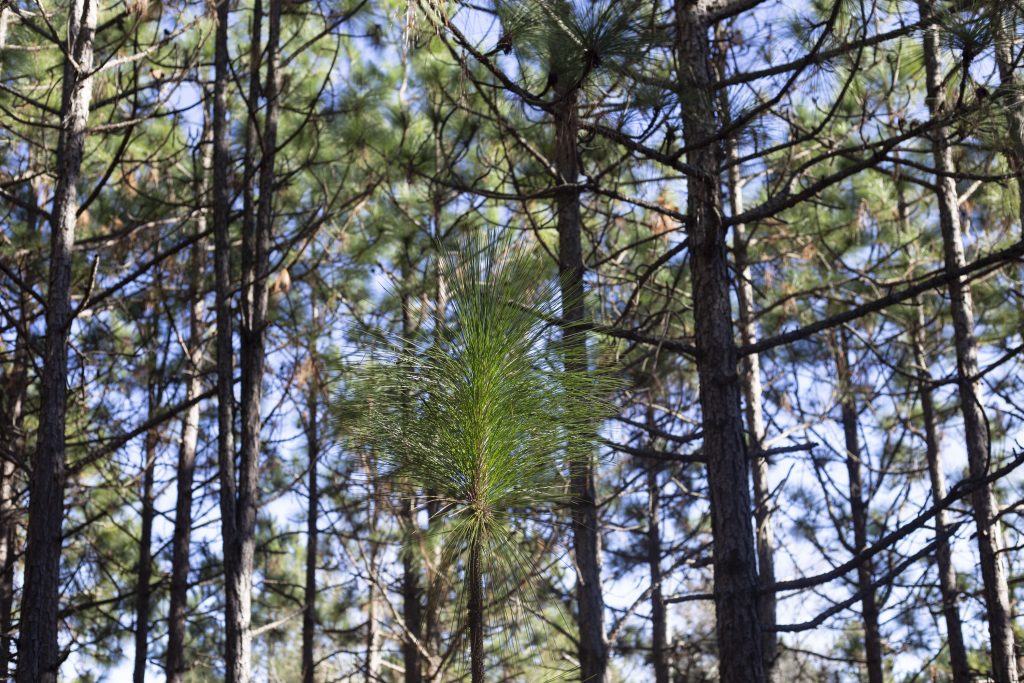 Hundreds of years ago, from the Triangle to the coast, millions of acres of longleaf pine towered over green and golden grassland. Lightning-caused wildfires eliminated the mid-story while savanna grasses, low shrubs, and herbaceous plants thrived as habitat and nutrient sources for thousands of species under longleaf pine trees.
Hundreds of years ago, from the Triangle to the coast, millions of acres of longleaf pine towered over green and golden grassland. Lightning-caused wildfires eliminated the mid-story while savanna grasses, low shrubs, and herbaceous plants thrived as habitat and nutrient sources for thousands of species under longleaf pine trees.
Healthy longleaf pine ecosystems are second only to the rainforest in biodiversity. Today, only about 3 million acres of native longleaf pine remain of the original 93 million acres that covered the Southeast. As more people have come to appreciate the incredible biodiversity hosted by this ecosystem, restoration and conservation efforts have increased. TLC is restoring longleaf pine at Bailey and Sarah Williamson Preserve, where the sandy uplands were once covered by the tree.
“Longleaf is a tree of the future rather than the tree of the past,” said Julie Moore, founding board member of The Longleaf Alliance. “It’s more disease resistant. It can take extreme conditions, very dry, very wet, and major winds.”
Longleaf pine has had to overcome centuries of challenges. The Triangle lies in the western most reach of the tree’s range in North Carolina, a state so connected to the tree that it’s referred to as “the land of the longleaf pine” in the official state toast. In the 19th and 20th centuries, when pine resin was an integral part of the naval industry, longleaf pine trees were tapped to make tar and turpentine. Stands were later clear cut for agriculture and virgin timber, especially in the Piedmont region. Longleaf pine is often thought of as a sandhills tree, but that’s only because the sandy soils there weren’t as suitable for other agriculture.
Later in the early 1900s, after a growing public fear of wildfires, the U.S. Forest Service adapted a strategy of suppression and prevention, which affected the health of longleaf forest ecosystems. Longleaf pine forests require fire to become established and thrive. The fire-intolerant loblolly pine, which supports much less wildlife, grew in moist habitats and started to replace longleaf forests.
For decades, few were inspired to do anything about the dwindling range of native longleaf pine, Moore said. But in the 1980s, ecologist Joan Walker’s Ph.D. work in the Green Swamp in Brunswick County demonstrated the high number of species living in a well-burned longleaf pine forest. Once conservationists realized the biodiversity made possible in a regularly burned forest of a single tree species, restoration efforts increased dramatically throughout the South.
“Today we know how to produce longleaf seedlings with high survival rates, the various techniques for planting them, and how to suppress competitive native and nonnative species,” Moore said.
 At Williamson Preserve, TLC volunteers and staff planted about 3,500 longleaf pine seedlings during a workday with Appalachian Mountain Brewery and The Longleaf Alliance in February 2019. These organizations continue to partner to restore this important ecosystem, including during a second workday in 2020. Yearly prescribed burns will help this habitat build up again in an area that for hundreds of years was used as farmland. There are challenges ahead to recreate the distinct ground cover of grasses, herbs, and low shrubs.
At Williamson Preserve, TLC volunteers and staff planted about 3,500 longleaf pine seedlings during a workday with Appalachian Mountain Brewery and The Longleaf Alliance in February 2019. These organizations continue to partner to restore this important ecosystem, including during a second workday in 2020. Yearly prescribed burns will help this habitat build up again in an area that for hundreds of years was used as farmland. There are challenges ahead to recreate the distinct ground cover of grasses, herbs, and low shrubs.
But longleaf pines are resilient, and they grow deep tap roots — both in the ground and in the history of North Carolina. In the land of the longleaf pine, people care about the future of the tree. Just down the road in downtown Raleigh, The Longleaf Hotel is supporting restoration efforts in the Triangle.
With some care, longleaf stands will thrive again, and with them, so will the savanna grasses and the incredible number of species attracted to the open, sunny conditions. In a few decades at Williamson Preserve, the seedlings, looking like grass right now, will stand tall, filtering light through their long green needles and casting a glow over all the life on the ground.
